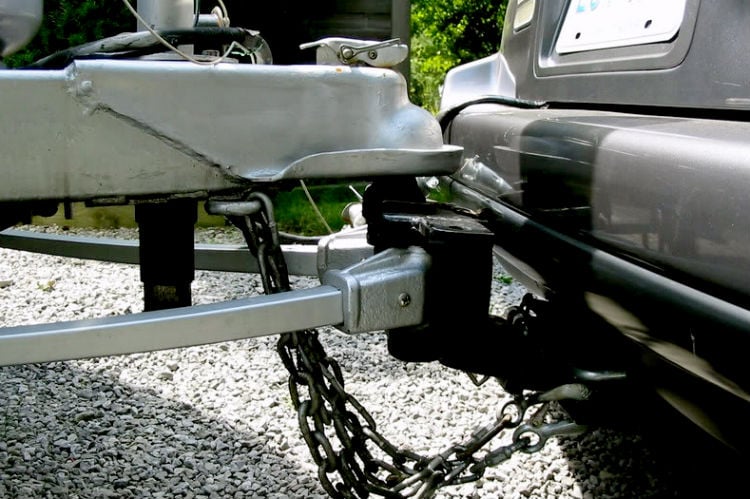RV Weights: What They Really Mean
RV weight isn’t exactly a glamorous topic in the world of RV literature. It’s probably one of the most important maintenance and preventative maintenance topics to cover, but it’s not exactly drawing crowds of RVers, frothing at the mouth to learn “Payload = GVWR-UVW.”
Fortunately, the math presented here is fairly straightforward. Besides, RV weights matter a great deal. Safety, towing, compliance, and avoiding damage are all wrapped in shiny acronyms and basic equations. If you’re going to tow or operate an RV, this info is invaluable.
Even seasoned RVers may find a thing or two of interest amongst the myriad ciphers that stand for all things RV and weight. Gravity is a heck of a thing, and if you are unfamiliar with this force, as it applies to RV weights, you may find yourself in a good deal of trouble on the road.
Why RV Weights Matter

Some aspects of RV weight management are obvious. If your RV is too heavy, it could compromise vehicle control, cause tire blowouts, damage axles, or result in trailer detachment. Safety for yourself and others should always be your No. 1 priority when heading out on the highway.
But there are more subtle issues at play, too.
- Unstable Handling: Increased sway, too much centrifugal force when turning, uneven weights lifting the front wheels, and difficulty braking.
- Vehicle and Trailer Longevity: Stresses on the chassis, suspension, tires, and brakes take a toll. The hitch and frame are at risk as well.
- Fuel Efficiency: As you can imagine, heavier RVs require more power to pull, reducing MPG.
- Legal and Insurance Compliance: States enforce varying degrees of weight regulations on the road, and overloading may result in fines, vehicle impounding, and failed inspections. Plus, insurance claims may be denied if the RV’s weight violates safety standards.
- Comfort and Convenience: Reduced storage and living space impact both, while RV weight management, in general, will likely cause more breakdowns and maintenance costs.
In other words, managing your RV’s weight is non-negotiable, covering the safety of yourself and others, along with remaining within the legal safety standards of the states you travel through.
As with everything nowadays, there are several acronyms you need to learn as well, such as CCC, GVWR, GCWR, and more. The differences between them are both subtle and stark, but necessary knowledge, nonetheless.
Breaking Down Key RV Weight Terms
With that out of the way, it’s time to dig into the fun stuff—key RV weight terms. If this is your first time delving into this topic, feel free to grab a pen and paper (yes, an actual pen and paper, not a smartphone screen) and write them down. Slap the paper on your fridge and you’ll have a simple reference sheet available whenever it’s needed.
- Dry Weight: RV’s weight without fluid, cargo, passengers, or accessories (straight from the factory). It’s a baseline for calculating payload and modifications. It’s NOT always the same as unloaded vehicle weight (UVW), which may include factory-installed options.
- Curb Weight: The weight of the vehicle (RV or tow vehicle) as it sits “at the curb,” ready to drive, with standard equipment, full fuel tank, coolants, and other essential fluids. This figure does not include passengers, cargo, or aftermarket accessories.
- Gross Vehicle Weight Rating (GVWR): This is the maximum allowable weight of the RV, including passengers, fluids, cargo, etc.
- Gross Combined Weight Rating (GCWR): The maximum allowable weight of the tow vehicle and the RV together.
- Payload Capacity: The weight the a vehicle (tow vehicle or RV) can safely carry beyond the dry weight.
- Occupant and Cargo Carrying Capacity (OCCC): The weight available for passengers and cargo, excluding water and propane (specific to motorhomes).
- Hitch Weight (Tongue Weight): The weight the trailer exerts on the tow vehicle’s hitch (typically 10–15% of trailer weight).
- Wet Weight: Dry weight plus fluids (not as prevalent a term as the others).
- Gross Axle Weight Rating (GAWR): Maximum allowable weight per axle.
With the possible exception of “wet weight,” above are terms you will deal with and hear about most often. RV weight management can become a bit finicky, especially when arguing the differences between UVW and dry weight. Usually, that difference is non-existent, but it comes into play more often when purchasing used.
“To know your true cargo carrying number weigh the rig empty, then subtract that number from your placard GVWR. The difference is what you can carry. Like Gooma says, it doesn’t matter what it is, people, clothes, gas, propane, it’s all weight and you cannot exceed the GVWR with any of it. You don’t get to subtract anything.”
For instance, you may see the UVW for an RV by looking it up on the manufacturer’s website. However, the RV owner you’re buying from may have requested a particular add-on or modification prior to purchase. Most RVs list the various dry weights of floorplans and options, but not always to the specific degree necessary if you’re towing the line on the weight.
RV Weight Examples
To better define RV weight terms, examples are necessary. Throwing around a bunch of acronyms regarding RV weight isn’t too helpful on its own. So, let’s start with examples in the same order as the above list of definitions.
- Dry Weight: An RV, straight out of manufacturing, with nothing new added. A travel trailer with a 5,000-pound dry weight is often what you’ll see advertised with each floorplan.
- Gross Vehicle Weight Rating (GVWR): A motorhome with a 20,000-pound GVWR must stay under this weight limit when fully loaded and ready to hit the road.
- Gross Combined Weight Rating (GCWR): A truck with a 25,000-pound GCWR towing a 10,000-pound trailer leaves 15,000 lbs for the truck.
- Payload Capacity: A 7,000-pound GVWR RV with a 5,000-pound dry weight has a 2,000-pound payload.
- Occupant and Cargo Carrying Capacity (OCCC): A Class C motorhome with a 1,500-pound OCCC can carry that much in people and the belongings they carry with them.
- Hitch Weight (Tongue Weight): A 6,000-pound trailer may have a 600–900-pound hitch weight.
- Wet Weight: An RV with a wet weight listed includes the dry weight of the RV, with all fluids on board, tanks filled, propane, gasoline, etc.
- Gross Axle Weight Rating (GAWR): A dual-axle trailer with a 5,000-pound GAWR per axle is listed per axle, not a combination of the two axles. It also does not directly relate total GVWR, since GVWR has to account for other factors, such as hitch weight. Fun stuff!
How to Calculate and Manage RV Weights
CAT scales and truck stops are your best bets for RV weight management. There are roughly 2,000 CAT scale locations in the US and Canada, and you’ll mostly find them at truck stops. That’s not a lot, considering the scale of U.S. and Canadian real estate. Fortunately, many travel-stop locations often have scales. In total, you’re looking at a scale every 50–100 miles or so.
GVWR
First things first. Weigh your RV at a CAT scale or truck stop. Gross vehicle weight includes everything—your curb weight, passengers, fluids, and accessories. It’s a weight the RV’s manufacturer provides, so you need to make sure you don’t exceed it. The GVWR is typically located on the RV’s data plate/sticker, which itself is located on the left-front side of the trailer, inside a cabinet, a closet, or near the entry door.
In a motorhome, it’s usually in the driver’s area, like the door jamb, dashboard, or near the seat. Now, let’s say your RV’s GVWR is 11,000 pounds. You’re all loaded up and parked on a CAT scale with a total weight of 10,200 pounds. This means you are 800 pounds below the GVWR, which is within the safety limits. Remember, GVWR is a fixed weight, provided by the manufacturer.
The primary thing you have to worry about is whether the RV weight, fully loaded, with you and your family, dogs, pet iguanas, etc., is less than that GVWR.
Payload and OCCC
This is where dry weight plays a role. Payload = GVWR – dry weight. If the GVWR is 7,000 pounds and the listed dry weight is 4,250 pounds, you have a payload of 2,750 pounds.
OCCC (Occupant and Cargo Carrying Capacity) is another manufacturer-provided number you’ll see often. It’s a specific term, used primarily in motorhomes. It typically indicates the maximum weight of occupants and full water tanks (fresh only) that the RV can carry, assuming no other fluids. OCCC = GVWR – UVW – weight of a full fuel tank – weight of full propane tanks.
The entire purpose of the OCCC is to measure the “livable load.” Sure, it gets confusing when you throw in terms like “dry weight” and “UVW,” but think of it as primarily being associated with motorhomes. It’s not a term you have to rely on with a fifth-wheel, truck camper, or travel trailer. OCCC is primarily there for you to budget your passenger and cargo weights.
GCWR and Towing Capacity
The most important thing to know about GCWR is that it’s not a number you calculate. It’s a manufacturer-specified rating. GCWR varies by engine type, axle ratio, cab/bed configuration, and 2WD versus 4WD. In RV weight management, the GCWR is useful for calculating tow capacity.
As you might have guessed, towing capacity is the maximum weight the tow vehicle can, well, tow. It’s calculated with a simple equation: Towing Capacity = GCWR – Actual Tow Vehicle Weight.
The actual tow vehicle weight comes with its own equation: Actual Tow Vehicle Weight = Curb Weight + Payload.
Hitch Weight
This is where RV weight management gets a little complicated. Drive to a weight scale with your trailer fully loaded, as if you’re about to hit the road on your first camping trip (water, gear, everything you need). Know your truck’s curb weight. Drive your truck and hitched trailer onto the scale—front wheels on platform 1, back wheels on platform 2, and trailer on platform 3.
“Your real-world hitch weight once you get loaded up and ready to travel will be quite a bit higher than any advertised hitch weight.”
If you have a weight distribution hitch (WDH), take off the bars so the scale can determine the real hitch weight. The scale will tell you the weight forward, back, and the trailer. Take the truck’s total weight with the trailer hitched, and subtract the truck’s curb weight alone. Now you have your hitch weight, which should be 10%–15% of the trailer weight.
There’s a second method as well. You can purchase a Weigh Safe hitch for $200–$300 that fits onto your regular hitch or W-D hitch. All you have to do is connect your trailer to your truck on a flat spot, disengage the W-D bars (if applicable), and the Weigh Safe hitch will reveal the hitch weight on a small screen or send the info to your phone via an app.
You can always guess your hitch weight by calculating 10%–15% of your trailer’s weight, but it’s always best to be as accurate as possible when you’re not in a pinch.
GAWR
Like GCWR, GAWR is a given weight, not one you have to calculate. The GAWR should be located on your RV’s data plate/sticker. However, you may need to ensure that the axles are under the listed GAWR by once again heading to the local truck stop.
As with determining hitch weight, you want to make sure each axle is parked on its own platform, and the scale will do all the legwork for you. Simply compare the scale’s feedback with the GAWR listed on the data plate. You never want to overload the axles and the best way to do that is to carefully distribute the weight in your RV and towing vehicles.
Common Mistakes and How to Avoid Them
Most veteran RVers have been doing this for a long time, and distributing weight throughout the RV is second nature. However, RV weight management is a fresh concept that newcomers often fail to calculate. Especially with big RVs that look like they can hold the entire world within and be just fine.
Mistake #1: Ignoring GVWR/GCWR
RV manufacturers are projected to ship more than 350,000 RVs in 2025, and many of them are for first-time buyers. Many have never even heard of the term “GVWR” or “GCWR,” much less “curb weight,” or “GAWR.”
Regardless, ignoring these numbers leads to unsafe towing, potentially on a catastrophic scale. It’s not unheard of for an improperly matched RV to detach from a tow vehicle while moving down the interstate.
Even if nothing goes wrong, it could still result in fines, depending on state laws. An accident will undoubtedly lead to a voided warranty, no insurance coverage, and more complicated legal problems.
Check the stickers, contact the manufacturer, and avoid overpacking. Driving safely is not just a matter of minding your Ps and Qs on the highway. It’s also your responsibility.
Mistake #2: Overestimating Payload
Your RV may look like a tank on wheels, like the Crawler Caravans or the MDCs, but that doesn’t mean it can carry more than it’s designed for. If your RV has a 7,000-pound GVWR and a 5,000-pound dry weight, there is a 2,000-pound cargo allotment, even if it looks like it can carry the Empire State Building across a mudhole or a sandy beach.
Speaking of a 2,000-pound allotment, there’s very little sense in trying to pack it so full that you get 1,999.99996 pounds in there and call it a day. Technically, that should be fine, but you’re flirting with the very edges of what the RV is capable of. You’re also looking at reduced fuel efficiency, parts wearing out faster, potential hitch trouble, increased trailer sway, and more difficulty stopping—especially if you suddenly have to do so on a dime.
Mistake #3: Neglecting Hitch Weight
Perhaps I should have clarified above: Hitch weights “seem” more complicated, especially for the discerning newbie. Compared to simply knowing your RV weight management numbers, hitch weight is a little more complicated. However, we’re not boldly marching into the intricate realm of string theory and nonlinear dynamics here.
Failing to keep up with the hitch weight is likely to create an unstable ride, lift the front of the truck, make the trailer wobbly, damage the hitch altogether, stress the truck’s engine and suspension, create tire or axle trouble, snap free, and create massive safety, insurance, and warranty issues.
Check your weights, make sure your hitch is 10%–15% of the trailer’s weight, and ensure the rest of the weights are within safety specs.
Mistake #4: Assuming Brochure Weights are Accurate
Go to most RV sites, choose an RV, choose a floorplan, and you’ll likely see GVWR, UVW, and Hitch Weight. A bag of chips may read “17 1/4 ounces,” but weighing the chips out of the bag may tell a different story. The weights displayed on each RV are for basic models, unless otherwise listed.
“Actually, the GVWR numbers can be misleading. I have seen two very similar fifth wheels, with very similar dry weights, but with vastly different GVWRs. The reason? The axles. The “lighter” trailer had 4000 lb axles, the other 5000 lbs.”
Fancy awnings, larger RV fridges, and other accessories may not be included. Plus, RV manufacturers list the weight of a model, but that doesn’t mean every model that comes off the assembly line is exactly the same. Sometimes, brochures and adverts use averages or older model weight numbers.
Always determine the weight for yourself, including any add-ons, gear you bring to the table, and changes you make to the RV’s interior or exterior.
Conclusion
RV weight management doesn’t have to be an overly complicated process, but it is a necessary process. For the safety of yourself, those in your care, and everyone driving around you on the highway, you need to know and calculate the numbers. Use this weight guide to cover your bases and make sure you’re not mixing up one value with another.
Check your RV’s labels, weigh your RV and tow vehicle (if the latter is applicable), and pack it accordingly. Don’t flirt with the maximum number either. If you’re consistently approaching the max, maybe it’s time to invest in something a little bigger.
If there’s anything you want to add concerning RV weight management or your own experiences dealing with it, let us know in the comments!
The post RV Weights: What They Really Mean appeared first on RV LIFE.
Source: https://rvlife.com/the-truth-behind-rv-weight-labels/







